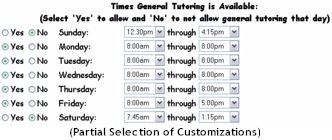









 |  |  |  |  | |
 | |||||
When you are running your tutoring system, it has to be your tutoring system. Virtual Tutor Coordinator V3.1 can be customized in many ways so that the software works for your tutoring system, and not the other way around. The customizations listed on this page can all be done through a few clicks of a button, but when you purchase VTCV3.1, you may request other customizations which may be done free of charge. Included with the purchase of Virtual Tutor Coordinator V3.1, you get three free hours of customizations, though we will often do more at no additional cost.

- A partial list of things that you can customize:
- Messages: You can set certain messages that will appear on the tops of different pages, as well as messages that will be in certain e-mails.
- Evaluations: You may customize student and tutor evaluations, which are filled out by students and tutors for each tutoring session in which they participate. The way the user inputs answers to questions in these evaluations can include drop-down box selection, option button selection, check boxes, text boxes, and text area boxes (multi-line text boxes). You can also select at any time whether you would like the evaluations to show at the time (e.g. at the end of semesters).
- Special Status: If you have two different types of students (e.g. TRIO and Peer) where one may have different tutoring privileges from the other, you can select that option and set what the names of the special and regular students are.
- Meeting Scheduling: For both regular and special status students, you can set the following items: If they initially have the ability to schedule their own meetings (an option which you can later add or take away from individual students) and then how many hours of tutoring they can sign up for on their own, and how many sessions they can sign up for on their own in the same course. If you want to set a length (e.g. one hour) of all meetings which students sign up for, you can do that as well.
- Special Classes: If you choose to dilineate regular and special students, you can set courses which only special status students can have tutoring in. For those classes, you can also set messages which regular status students will see if they apply for tutoring in those courses (though the tutor coordinator is always permitted to sign up any students for those courses).
- Tips: You can set up tips which will be shown for students or tutors visiting their respective My Tutor CoordinatorTM pages. You may also customize VTCV3.1 to not show tips for students and/or tutors. Many useful tips are pre-entered in VTCV3.1.
- Meeting Codes: If you wish to store Accounting Codes, Meeting Details, Contact Types, Service Codes, or Pay Codes with each meeting, you can customize the options for each of those fields.
- Meeting Colors: Meetings may show up in different colors which indicate each meeting's attributes. You can customize the colors which meetings will show up in if they have any of the following properties: Removed, Paused, Pending, or Inactive.
- Website Colors: The background and text colors, as well as the font type used on the site can be customized.
- Automatic E-mails: If you wish to have relevant e-mails sent to system users, you can set that option, though students and tutors are given the option to not receive non-essential e-mails. You may also select to have all e-mails doubled as system messages; e-mails that can't be sent because the recipients chose not to accept the e-mails or because you have selected not to send e-mails will instead be sent as system messages.
- Simultaneous Sessions: You can set the maximum number of one-on-one sessions that a tutor can have at the same time involving regular status students and special status students. These meetings must all be with students receiving tutoring for the same course.
- You should also specify the minimum number of days notice a student must give to pause a meeting and avoid being charged as having missed it. Below that you can specify the percentage of their usual hourly pay that the tutor will receive for sessions which a student misses without proper notice. Then, if you want, you can set the number of times that a student can miss a specific meeting and the number of overall misses a student may have before the tutor coordinator is notified and given the option to remove the meeting or student.
(C) 2004 Guy Goldstein
